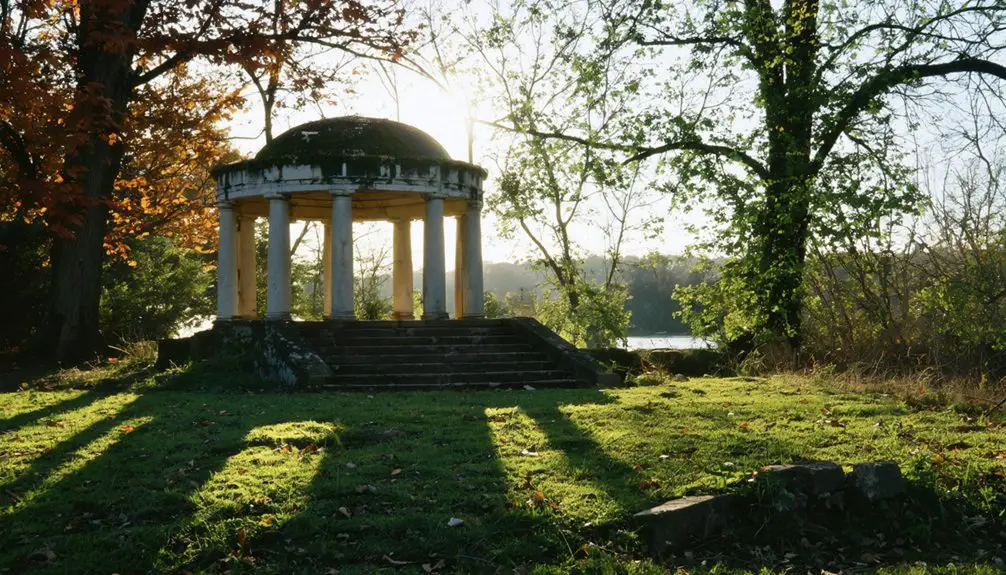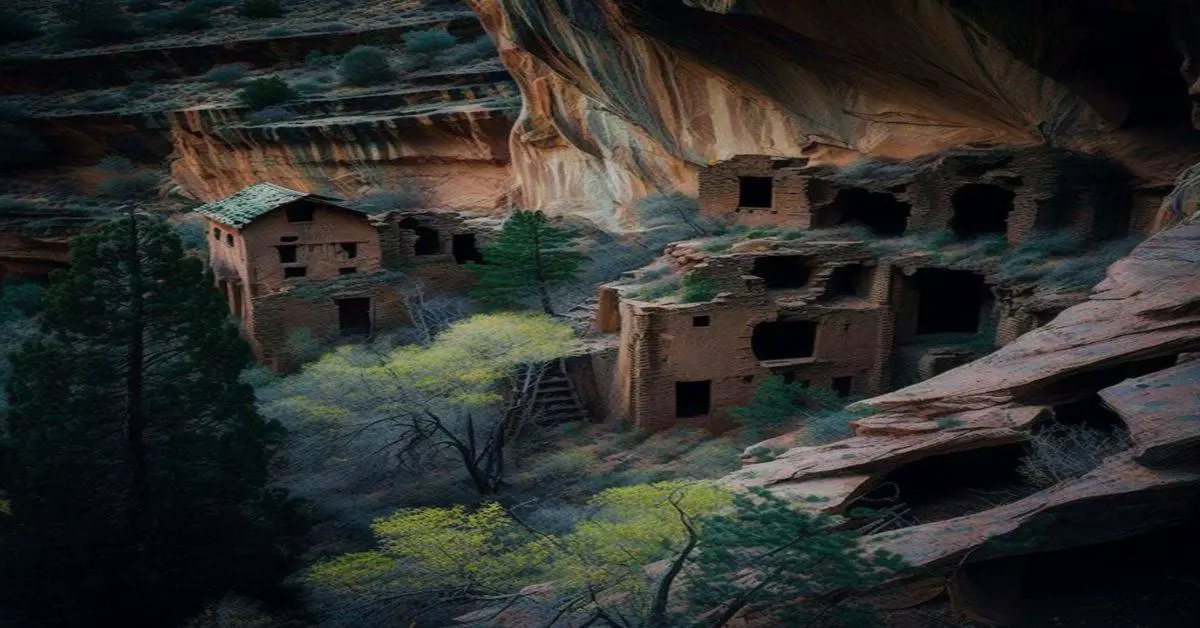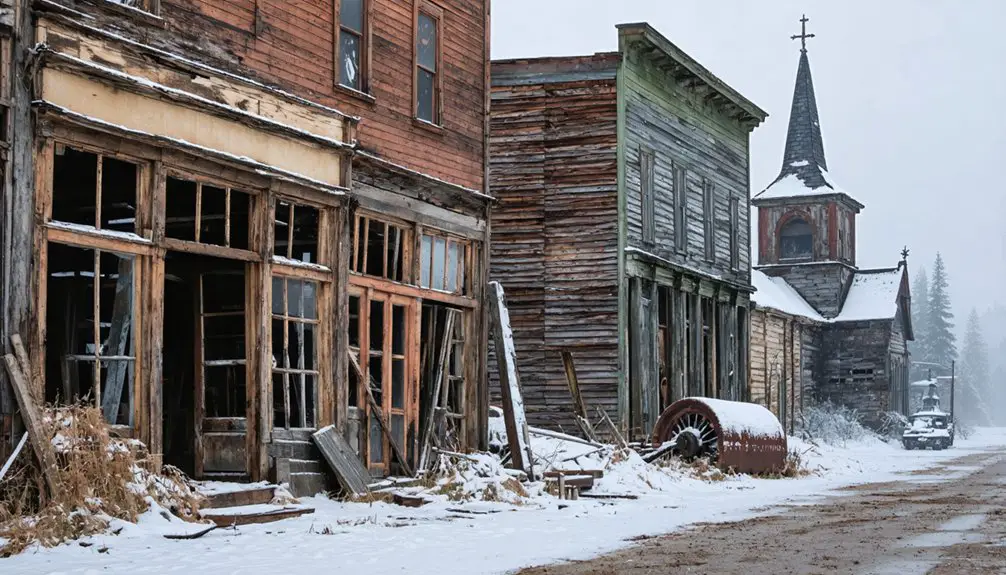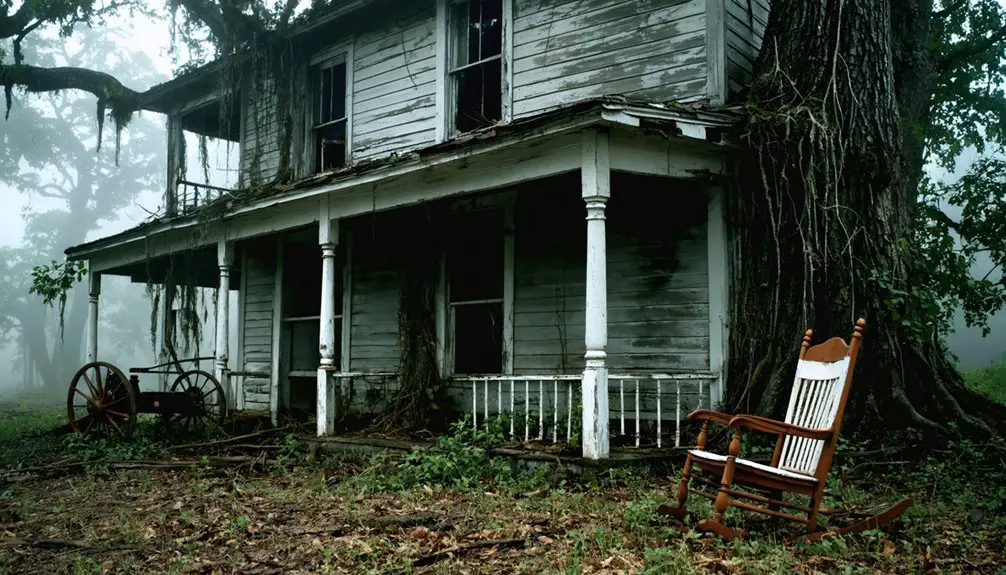You’ll find the haunting ruins of Blue Sulphur Springs Resort in Greenbrier County, where a lone Greek Revival pavilion stands as the last remnant of an elegant 1834 retreat. The 200-room resort once hosted presidents Andrew Jackson and Martin Van Buren, featuring America’s first mud baths and healing mineral waters. Union forces burned the grand hotel in 1864, transforming this Southern aristocrats’ paradise into a ghostly reminder of antebellum luxury. The pavilion’s twelve Doric columns still guard fascinating stories of glory and decline.
Key Takeaways
- Blue Sulphur Springs transformed from a luxurious 200-room resort into a ghost town after Union forces burned it in 1864.
- The once-bustling resort town hosted 3,000 guests at its peak but was abandoned after the Civil War’s destructive impact.
- Only the Greek Revival Pavilion remains standing from the original resort complex, marking the ghost town’s former grandeur.
- Nearly 100 Confederate soldiers died at the site in 1863, contributing to its reputation as a Civil War-era ghost town.
- The abandoned resort town’s sulfur spring continues to flow at six gallons per minute, marking the location’s historic significance.
The Rise of an Elegant Mountain Resort (1834-1860)
Nestled in the rolling mountains of Greenbrier County, Blue Sulphur Springs emerged in 1834 as one of the most ambitious resort developments in antebellum Virginia.
George Washington Buster’s vision transformed a simple sulfur spring into an elegant retreat, complete with a magnificent three-story brick hotel boasting 200 rooms and America’s first mud baths.
From humble mineral waters, Buster crafted an opulent oasis where America’s first mud baths beckoned the privileged to indulge and unwind.
You’d have found yourself among the nation’s elite here during the 1840s, rubbing shoulders with presidents Andrew Jackson and Martin Van Buren in the Greek Revival pavilion.
The social dynamics revolved around Southern aristocrats who’d journey from the Deep South by riverboat and stagecoach, seeking refuge from summer heat.
The architectural features included private cottages and specialized bathing facilities, all strategically positioned along the Midland Trail to attract wealthy travelers exploring the Virginia springs circuit.
The resort’s reputation drew distinguished statesman Henry Clay as a frequent visitor, adding to its prestige among the social elite.
Among its notable guests was Jerome Bonaparte, whose visit further cemented the resort’s status as a premier destination.
Pioneering Health Treatments and Famous Visitors
While the resort’s elegance drew visitors from afar, it was the healing properties of Blue Sulphur Springs’ mineral waters that truly put it on the map.
You’d find Dr. Alexis Martin, Napoleon’s former surgeon, overseeing innovative treatments like Tartarean ovens and America’s first mud baths. The 53-degree sulfur water promised cures for everything from liver disease to typhoid fever. A Greek Revival temple sheltered the pristine spring fountain at the center of the valley.
The healing waters attracted an impressive roster of notable visitors:
- Presidents Andrew Jackson, Martin Van Buren, and William McKinley sought refuge from political pressures
- Robert E. Lee and Henry Clay joined the parade of influential guests
- Travelers journeyed from as far as New Orleans, creating social networks while “taking the waters”
The resort’s unique blend of European-inspired balneotherapy and American entrepreneurship made it a pioneer in health tourism. The resort could accommodate up to 300 people at its peak, making it a significant destination for health-seeking travelers.
Civil War’s Devastating Impact on the Springs
During the Civil War, Blue Sulphur Springs transformed from an elegant health resort into a grim military outpost, where both Union and Confederate forces vied for control.
The military occupation brought devastating consequences – in 1863, nearly 100 Confederate soldiers perished from disease and exposure while wintering at the springs. They were buried on nearby hillsides in coffins made from the resort’s own furniture. Local troops engaged in the fierce Battle of Dry Creek nearby, which resulted in heavy casualties for both sides. The springs’ decline mirrored other Virginia mineral springs that experienced wartime destruction.
You would’ve witnessed the grand hotel, once capable of hosting 3,000 guests, gradually crumble under the weight of combat and continuous military use.
In 1864, Union forces deliberately torched the complex to prevent Confederate use, leaving only the spring pavilion standing. The economic disruption permanently crippled the resort’s operations, while divided loyalties tore apart the social fabric of the surrounding Greenbrier community.
From Luxury Resort to Abandoned Ruins
You’d have found Blue Sulphur Springs at its peak in the 1840s, hosting presidents and dignitaries in its 200-room brick hotel with innovative mud baths and health treatments.
The resort’s grandeur came crashing down during the Civil War when Confederate soldiers made coffins from its furniture and Union troops burned the buildings, leaving only the Greek Revival Pavilion standing. Today, visitors can view the historic site under the care of the Greenbrier Historical Society.
What was once a luxurious destination transformed into a haunting reminder of antebellum resort culture, with the surviving Pavilion marking where wealthy visitors once sought the healing powers of the sulfur springs. The spring continues to flow today, delivering six gallons per minute of mineral-rich water into the Pavilion’s marble basin.
Resort’s Golden Age
As the nation’s wealthy sought refuge from city life in the 1830s, Blue Sulphur Springs Resort emerged as a premier destination under George Washington Buster’s vision.
The resort’s luxury accommodations, including a 200-room brick hotel and private cottages, drew America’s elite seeking health tourism experiences in the Appalachian wilderness.
After years of success, the resort’s decline began when the railroad tracks moved in 1909, leading to decreased visitor access.
You’d find these innovative treatments at the height of the resort’s popularity:
- The nation’s first curative mud baths, pioneering a new era in American spa culture
- Tartarean ovens providing revolutionary vapor treatments with mineral-rich waters
- Therapeutic services overseen by Dr. Alexis Martin, Napoleon’s former army surgeon
Presidents Jackson and Van Buren walked these grounds, while Henry Clay and Robert E. Lee enjoyed the resort’s renowned sulfur springs.
The Greek Revival pavilion stood as a symbol of the resort’s grandeur, sheltering the precious spring waters that drew visitors across the nation.
Today, the twelve Doric columns remain as the last testament to this once-flourishing resort destination.
War’s Devastating Impact
The luxurious resort’s golden age came to an abrupt end when the Civil War erupted across the nation.
As military strategy shifted to controlling the region, both Union and Confederate forces transformed your beloved health retreat into a strategic outpost and makeshift hospital.
You’d hardly recognize the site in 1863 when a tragic disease outbreak struck a Georgia regiment wintering there. Nearly 100 Confederate soldiers perished from illness and exposure, their bodies hastily buried on a nearby hillside in makeshift coffins crafted from resort furniture.
By 1864, Union troops sealed the resort’s fate by burning almost everything to the ground, leaving only the Greek-style pavilion standing.
What was once a symbol of healing and leisure became a haunting reminder of war’s devastation and human suffering.
The Last Standing Pavilion: A Historic Landmark
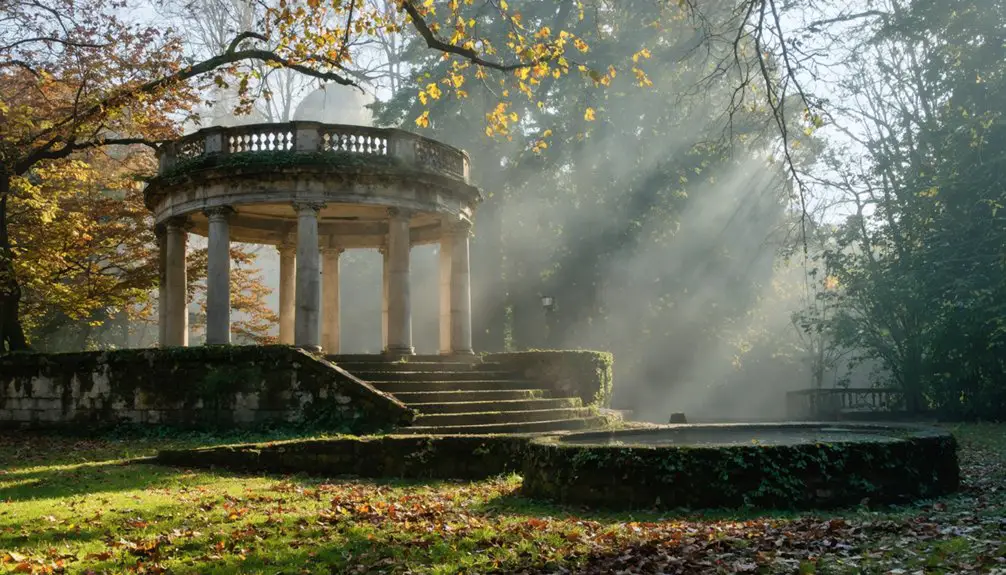
Standing proudly as the sole survivor of a once-bustling resort, Blue Sulphur Springs‘ Greek Revival pavilion has withstood nearly two centuries of history.
Its architectural significance shines through its classic columns and 32-foot square design, while housing the sulphur spring that drew countless visitors seeking healing waters.
You’ll find this cultural heritage landmark fully restored as of 2023, after years of dedicated preservation efforts saved it from near collapse.
- The pavilion welcomed American legends like Andrew Jackson, Henry Clay, and Robert E. Lee during its 1830s-1850s heyday.
- It introduced America’s first mud baths in the 1840s, revolutionizing health tourism.
- It survived the Civil War’s destruction in 1864 when Union troops burned the surrounding resort buildings.
Today, you can still visit this monument to America’s mineral spring resort era, standing defiantly against time where an elegant spa once flourished.
Preservation Journey and Modern Revival
Decades of deterioration threatened to erase Blue Sulphur Springs‘ last architectural treasure until preservation efforts finally gained momentum in 2013.
When the Preservation Alliance of West Virginia listed the pavilion as endangered, you’d have found local historical groups springing into action, securing crucial grants and private funding to save this irreplaceable landmark.
The 2020 restoration breathed new life into the pavilion through strategic structural upgrades while preserving its elegant Greek Revival design.
Community engagement proved essential, uniting volunteers, historians, and preservation experts in this ambitious revival.
You’ll now find this restored gem standing proud as West Virginia’s only remaining resort pavilion, a symbol of successful funding strategies and local determination.
The 2023 dedication marked a turning point, transforming a crumbling relic into a vibrant cultural heritage site.
Frequently Asked Questions
What Are the Current Mineral Content Levels of the Spring Water?
You won’t find current mineral content levels, since there’s no recent water quality testing or mineral analysis available – all we’ve got are historical records from the spring’s heyday.
Are There Any Documented Ghost Sightings or Paranormal Activities at the Ruins?
Keep your eyes peeled, but you won’t find concrete spectral evidence here. While the broader Greenbrier region’s alive with ghostly encounters, no documented paranormal activities exist at these specific ruins.
Can Visitors Still Access the Spring Water for Drinking or Bathing?
You won’t find direct spring access for drinking or bathing today. While the pavilion’s open for visits, there’s no verified water quality testing or facilities supporting traditional water-based activities.
What Happened to the Confederate Soldiers’ Graves After the War?
You’ll find the Confederate soldiers were reburied in a single memorial grave marked by a cross-shaped mound above a church, though their original burial site has been lost to time.
How Much Did It Cost to Stay at the Resort in 1834?
You’d have spent around $2-5 per day for luxury resort amenities in 1834, though exact pricing history isn’t recorded. That covered your room, mineral baths, and access to exclusive social events.
References
- https://www.wvencyclopedia.org/articles/560
- https://mountainmessenger.com/a-look-back-190/
- https://abandonedonline.net/location/blue-sulphur-springs/
- https://exhibits.hsl.virginia.edu/springs/blue/index.html
- https://www.youtube.com/watch?v=52aVXVVd_u8
- https://www.cyclingscenicwv.com/Greenbrier/BlueSulphur.pdf
- https://wvliving.com/its-good-to-be-blue/
- https://greenbrierhistorical.wordpress.com/tag/blue-sulphur-springs/
- https://www.wgpfoundation.org/historic-markers/the-pavilion/
- https://mds.marshall.edu/cgi/viewcontent.cgi?article=1941&context=etd
